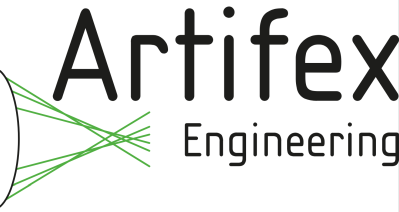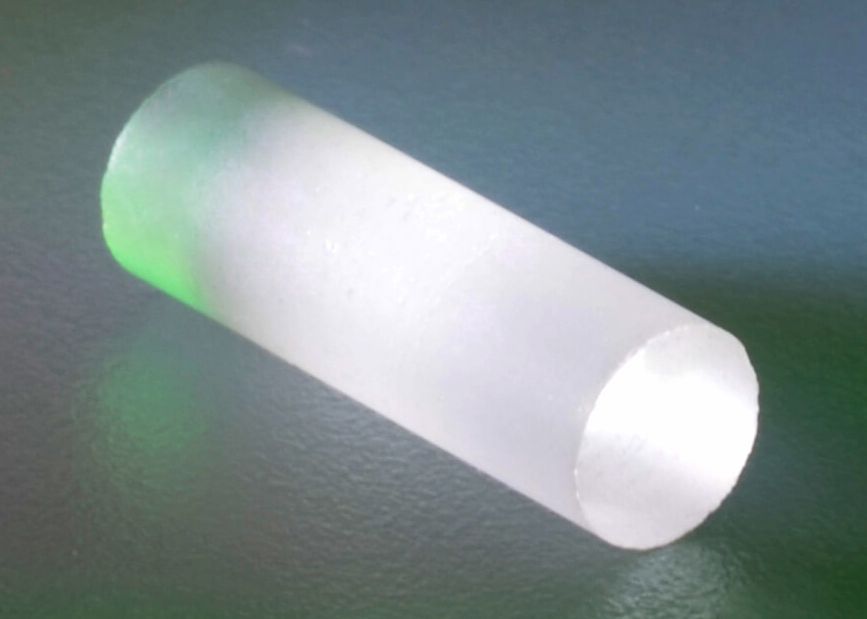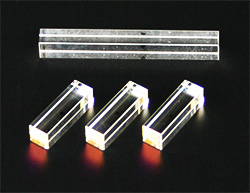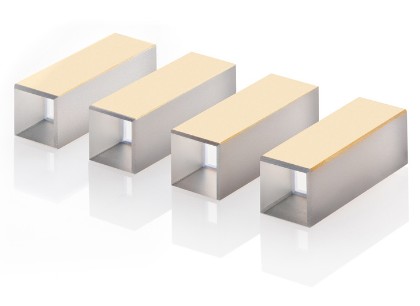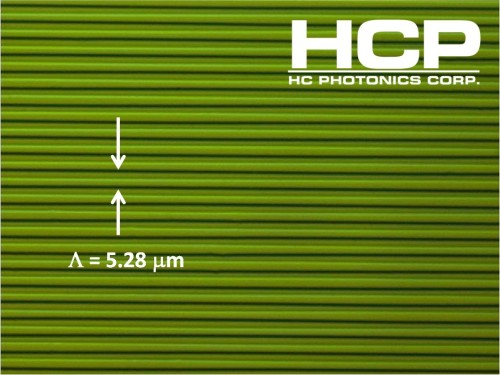nonlinear crystal materials (original) (raw)
Definition: crystal materials exhibiting an optical nonlinearity, usually of ($\chi^{(2)}$) type
More general term: optical materials
Categories:  optical materials,
optical materials,  nonlinear optics
nonlinear optics
Page views in 12 months: 5271
DOI: 10.61835/c3j Cite the article: BibTex plain textHTML Link to this page! LinkedIn
For purchasing nonlinear crystal materials, use the RP Photonics Buyer's Guide – an expert-curated directory for finding all relevant suppliers, which also offers advanced purchasing assistance.
Contents
Optical crystals can exhibit different kinds of optical nonlinearities, which can be utilized in various ways:
- Crystals with a not too high lattice symmetry exhibit a ($\chi^{(2)}$) nonlinearity. They are mainly used for parametric nonlinear frequency conversion (e.g. in frequency doublers and optical parametric oscillators), also for electro-optic modulators.
- Others only have ($\chi^{(3)}$) nonlinearities. Here, one may exploit the Kerr effect, e.g. for four-wave mixing. The delayed nonlinear response is the basis of Raman scattering and Brillouin scattering.
In essentially all cases, artificial (rather than naturally occurring) crystals are used.
Choice of Nonlinear Crystals
Many different properties of a nonlinear crystal can be important for an application e.g. in nonlinear frequency conversion:
- The magnitude of the effective nonlinear coefficient ($d_\rm{eff}$) depends on the nonlinear tensor components and on the utilized phase-matching configuration. A high nonlinearity is important particularly if the achievable optical intensities are low.
- The chromatic dispersion and birefringence properties determine the possibilities for phase matching and the phase-matching bandwidth, angular acceptance (for critical phase matching), etc.
- Normally, the crystal material should have a high optical transparency for all wavelengths involved – for example, for pump, signal and idler in an optical parametric amplifier.
Additional properties can be relevant for a comparison:
- the availability of crystals with consistently good quality, large size and a reasonable price
- the material's potential to be periodically poled to achieve quasi-phase matching
- linear absorption, which can cause heating at high optical power levels, so that the phase matching is disturbed, and thermal lensing may occur
- the ease of fabricating high-quality anti-reflection coatings on the crystals, which reliably adhere to the surfaces (even under conditions of substantial temperature changes, as sometimes required)
- the chemical durability; e.g., some crystal materials are hygroscopic, others undergo chemical changes when heated in a vacuum chamber for application of a dielectric coating
- the resistance against optical damage, gray tracking, photodarkening, green-induced infrared absorption, and the like
- the resistance against photorefractive effects (which are often called photorefractive damage, even though this is usually reversible)
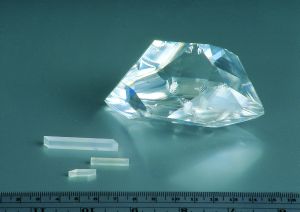
Figure 1: A block of LBO and some crystals cut from such material. The photograph has been kindly provided by EKSMA OPTICS.
The choice of the most suitable crystal material for a given application is often far from trivial; it should involve the consideration of many aspects. For example, a high nonlinearity for frequency conversion of ultrashort pulses does not help if the interaction length is strongly limited by a large group velocity mismatch and the low damage threshold limits the applicable optical intensities. Also, it can be highly desirable to use a crystal material which can be critically phase-matched at room temperature because noncritical phase matching often involves the operation of the crystal in a temperature-stabilized crystal oven. However, the feasibility of critical phase matching may be given only for sufficiently high peak powers.
Frequently Used ($\chi^{(2)}$) Nonlinear Crystal Materials
Lithium Niobate and Tantalate
Lithium niobate (LiNbO3) and lithium tantalate (LiTaO3) are materials with a relatively strong nonlinearity. They are often used for nonlinear frequency conversion and also for electro-optic modulators. Both materials are available in congruent and in stoichiometric form, with important differences concerning periodic poling and photorefractive effects (see below). Lithium niobate and tantalate are the most often used materials in the context of periodic poling; the resulting materials are called PPLN (periodically poled lithium niobate) and PPLT, respectively, or PPSLN and PPSLT for the stoichiometric versions. Both have a relatively low damage threshold, but do not need to be operated at high intensities due to their high nonlinearity. They have a tendency for photorefractive effects, which are detrimental for frequency conversion, but are used for, e.g., holographic data storage in Fe-doped LiNbO3 crystals. The tendency for “photorefractive damage” depends strongly on the material composition; e.g. it can be reduced via MgO doping and by using a stoichiometric composition.
Potassium Niobate
Potassium niobate (KNbO3) has a high nonlinearity. It is used for, e.g., frequency doubling to blue wavelengths and in piezoelectric applications.
KTP, KTA, RTP, RTA
Potassium titanyl phosphate (KTP, KTiOPO4) may be flux-grown (cheaper) or hydrothermal (better for high powers, lower tendency for gray tracking → photodarkening). The “KTP family” of materials also includes KTA (KTiOAsO4), RTP (RbTiOPO4) and RTA (RbTiAsPO4). These materials tend to have relatively high nonlinearities and are suitable for periodic poling.
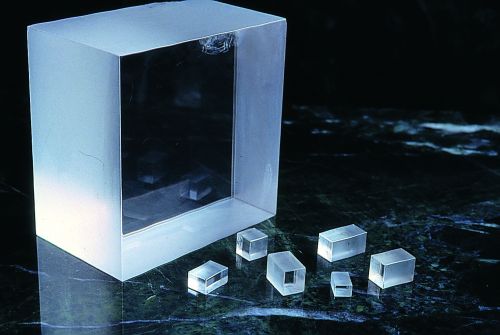
Figure 2: KD*P crystals, including one with very large size. The photograph has been kindly provided by EKSMA OPTICS.
KDP, KD*P
Potassium dihydrogen phosphate (KDP, KH2PO4) and potassium dideuterium phosphate (KD*}P or DKDP, KD2PO4, exhibiting extended infrared transmission), are available in large sizes at low price. They exhibit good homogeneity over large volumes and have a high damage threshold, but are hygroscopic and have a low nonlinearity.
Borate Crystals
There are a number of borates, the most important ones being lithium triborate (LiB3O5 = LBO), cesium lithium borate (CLBO, CsLiB6O10), β-barium borate (β-BaB2O4 = BBO, often used in Pockels cells), bismuth triborate (BiB3O6 = BIBO), and cesium borate (CSB3O5 = CBO). Borates are generally hygroscopic; that problem is severe e.g. for CLBO, also substantial for BBO, but much less for LBO.
Yttrium calcium oxyborate (YCOB) and YAl3(BO3)4 (YAB) are also available in rare-earth-doped form for use as laser gain media, and can then simultaneously generate and frequency-convert laser light.
Less frequently used are strontium beryllium borate (Sr2Be2B2O7 = SBBO) and K2Al2B2O7 (KAB).
LBO, BBO, CLBO, CBO and other borate crystals are suitable for the generation of relatively short wavelengths, e.g. in green and blue laser sources, and for UV generation (→ ultraviolet lasers) because their band gap energy is relatively high, the crystals are relatively resistant to UV light, and there are suitable phase-matching options.
Borates such as LBO and BBO also work well in broadly tunable optical parametric oscillators and optical parametric chirped-pulse amplification.
Mid-IR Crystals
For mid-infrared (and partly also terahertz) generation, one requires crystal materials with a transparency range extending far into the infrared spectral region. The most important of these media are zinc germanium diphosphide (ZGP, ZnGeP2), silver gallium sulfide and selenide (AgGaS2 and AgGaSe2), gallium selenide (GaSe), and cadmium selenide (CdSe). Gallium arsenide (GaAs) has also become useful for mid-infrared applications, since it is possible to obtain quasi-phase matching in orientation-patterned GaAs [13, 21]. There are also various barium-based crystal materials such as BaGa4S7, BaGa4Se7, BaGa2GeS6 and BaGa2GeSe6 [26].
Lifetime of Nonlinear Crystals
In many cases, a nonlinear crystal used for nonlinear frequency conversion has a very long lifetime, which is longer than that of the whole laser system. The crystal material is essentially not modified during operation. However, a reduced crystal lifetime can occur under various circumstances:
- Excessive optical intensities during operation may instantly damage a crystal. Unfortunately, nonlinear crystals often need to be operated not far from their optical damage threshold to achieve a sufficiently high conversion efficiency. This implies a trade-off between conversion efficiency and crystal lifetime. Note that even if the nominal intensity is below the nominal damage threshold, there may be problems due to fluctuations in the beam power or local intensity (e.g., if a beam profile has “hot spots”), or due to isolated defects in a crystal, which are more sensitive than the regular crystal material.
- Even well below the threshold for instant damage, some crystal materials exhibit a continuous degradation within the used volume, e.g. in the form of “gray tracking”. Such phenomena are particularly common for operation with ultraviolet light. Note that a gradual degradation can also lead into instant catastrophic damage via excessive heat generation.
- Hygroscopic crystal materials deteriorate when they are not always kept in sufficiently dry air (or a dry purge gas). This applies e.g. to KDP and BBO, and in a lesser extent to LBO. It can be helpful to keep such a crystal at a somewhat elevated temperature, which makes it easier to keep it dry.
- Operation of nonlinear crystals at temperatures below room temperature (to achieve phase matching) is generally problematic, as it may lead to condensation of water on the crystal surfaces if the surrounding air is not very dry. Even if the crystal material or coating is not sensitive to water, small water droplets may focus laser radiation more tightly than under normal operation, and thus damage the crystal material.
- Crystals which are non-critically phase-matched in a crystal oven may exhibit problems when the crystal temperature is changed too rapidly or too often. In particular, anti-reflection coatings may be damaged due to different thermal expansion coefficients of the involved materials.
Crystal lifetime can also be strongly dependent on the material quality, although certain degradation phenomena appear to be intrinsic limitations of the material.
For high-power UV generation, nonlinear crystals may become consumables: they rapidly degrade and need to be replaced quite often within the lifetime of the whole laser system (e.g., every few hundred hours of operation). Often, several problematic aspects come together in the regime UV generation:
- Crystal materials are generally more sensitive to ultraviolet light (having high photon energies).
- Crystals exhibit a higher absorption in that spectral region.
- In the case of ultrashort pulses the high group velocity mismatch enforces the use of a shorter crystal, which requires high optical intensities for a given conversion efficiency.
Very Thin Nonlinear Crystals
For some applications, nonlinear crystals with a very small thickness of well below 1 mm are used. This may be necessary for minimizing the group velocity mismatch, e.g. in optical autocorrelators for extremely short pulses.
A common method for obtaining ultrathin crystals is to first optically contact a thicker nonlinear crystal with some substrate (e.g. of fused silica) and then to polish the crystal down to the required thickness of e.g. 20 μm. The group velocity mismatch in the thicker substrate material may not matter, as the nonlinear interaction takes place only in the thin crystal. The substrate only serves to mechanically stabilize the thin nonlinear crystal.
It is also possible to fabricate free-standing crystals with a thickness of only 100 μm, sometimes even below 30 μm.
Related Articles
Suppliers
The RP Photonics Buyer's Guide contains 87 suppliers for nonlinear crystal materials. Among them:
Artifex Engineering
Artifex Engineering provides finished crystal optics for non-linear applications. Visit our product page for more information. We look forward to your inquiry.
ALPHALAS
Most of the standard nonlinear crystals like BBO, LBO, BiBO or KTP for frequency doubling, tripling and quadrupling of the fundamental laser radiation are available from stock. Customer-specific dimensions and AR coatings are also offered at competitive prices.
EKSMA OPTICS
EKSMA Optics offers a complete portfolio of nonlinear optical crystals: BBO, LBO, KTP, KDP, DKDP, LiIO3, LiNbO3, MgO:LiNbO3, AGS, AGSe, ZGP, GaSe, CdSe from stock or manufactured according to customers specifications or for specific applications.
Optogama
Optogama supplies a wide selection of high-performance nonlinear optical crystals designed for cutting-edge research and industrial laser systems. Our portfolio includes BBO, LBO, KTP, KDP, DKDP, LiNbO3, AGaSe2, AGaS2, ZGP, GaSe, and CdSe.
These materials enable a wide range of applications: harmonic generation, sum and difference frequency mixing, optical parametric generation and amplification, terahertz wave generation and detection, electro-optic Q-switching, and ultrafast pulse diagnostics (FROG, XFROG, SPIDER, d-scan, chirp scan).
All crystals are precision-grown and processed to meet demanding requirements for phase matching, transparency range, and damage threshold.
Laserton
Laserton offers various types of nonlinear crystals, including β-BBO, KTP and KTA, KDP & KD*P, LiNbO3, LBO, SBN and RTP.
GWU-Lasertechnik
GWU-Lasertechnik offers all standard nonlinear crystals like LBO, BBO and KTP with a broad variety of specifications. Beside the well-established materials, innovative crystals like CLBO or BiBO with outstanding properties for e. g. deep-UV generation or high-power ultrashort pulse lasers are available. No matter if individual pieces for R & D purposes are required or cost-efficient numbers in small, medium or large batches with in-time delivery for the production line are needed: GWU’s dedicated service helps to find the best core components for your application. GWU-Lasertechnik has more than 30 years of experience in distributing laser crystals. Choose GWU to benefit from our wide knowledge and in-field experience!
Covesion
Non-linear Optical (NLO) crystals provide an enormously flexible solution for generating new wavelengths from existing, off-the-shelf laser sources. The optical wavelength spectrum is utilized by a large and continually expanding variety of applications, from manufacturing of medical lasers, quantum networking & computing through to environmental sensing as well as many others.
With its high non-linear coefficient, ability to be periodically poled and broad optical transmission, MgO:PPLN becomes a highly flexible solution for the generation wavelengths from the blue (400 nm) through the mid-IR and beyond (THz).
HC Photonics
HC Photonics (HCP) provides various high efficiency nonlinear crystals to enable full-spectrum applications, including periodically poled lithium niobate (pp-LiNbO3, PPLN) and periodically poled lithium tantalate (LiTaO3)/PPLT.
Features and service:
- more than 250 commercial off-the-shelf PPMgO:LN bulk crystals for wavelength conversions: QPM pattern: single, multiple, and fan-out; configuration: SHG, SFG, DFG, OPG, OPO, OPA; wavelength range: UV (355 nm) to mid-infrared (5000 nm)
- custom-made solutions: QPM period: 2–1000 μm; QPM pattern: single, multiple, fan-out, chirped, cascade, 2D; dimension: length 0.3–80 mm, width 0.1–40 mm, thickness 0.2–5 mm); configuration: SHG, SFG, DFG, OPG, OPO, OPA, THG, SHG+SFG; wavelength range: UV (355 nm) to mid-infrared (5000 nm) and THz; material: PPMgO:LN or PPMgO:LT
- PPLN waveguides: excellent performance, i.e. >50% overall efficiency. Fibered module generating >2 W at 780 nm (1560 nm SHG) is off-the-shelf. Crystals for other wavelengths are also available or can be designed upon request.
Edmund Optics
Nonlinear crystals of either β-barium borate (BBO) or lithium triborate (LBO) are used for frequency conversion of laser sources. BBO crystals feature thicknesses from 0.2 mm to 0.5 mm to minimize group velocity mismatch and are ideal for frequency doubling or tripling of Ti:sapphire and Yb:doped laser pulses. The critical and noncritical phase matching LBO crystals are ideal for second or third harmonic generation of Nd:YAG and Yb:doped lasers.
Nonlinear crystals with 20-10 surface quality and λ/10 (LBO) or λ/8 (BBO) surface flatness provide the broad transparency range and large nonlinear coefficient needed for the harmonic generation of fundamental laser frequencies. Each crystal features a protective anti-reflection (AR) coating that minimizes reflection and limits fogging from ambient conditions.
Shalom EO
Shalom EO offers a vast selection of nonlinear crystals, including BBO, CLBO crystals, KDP and KD*P, LBO, KTP, HGTR KTP, KTA, BIBO, LiIO3, LiNbO3, MgO:LiNbO3, RTP, ultra-thin BBO, LBO crystals and infrared nonlinear crystals ZnGeP2 (ZGP). KGW crystals for stimulated Raman scattering are also available.
Our nonlinear crystals are excellent for applications ranging from frequency conversion to short-pulse generation. The NLO crystals offer reliable performance for harmonic generation (SHG, THG, 4HG, 5HG), sum and difference frequency generation (SFG, DFG), for optical parametric oscillators (OPOs) and optical parametric amplifiers (OPAs). Off-the-shelf and customized crystals are optional for our customers. Miscellaneous coating options including uncoated, AR, HR, HT, PR coatings, and custom coatings can be tailored. All the crystals will undergo rigorous inspection before dispatch.
Recent days, Shalom EO has launched CLBO crystals. The ClBO processed and polished in low humidity workshop are ideal for FHOG and FIHG for Nd: lasers, SHG and THG for Ti:sapphire and Alexandrite lasers, and micro-lithography.
In addition, electro-optic (EO) crystals and acousto-optic (AO) crystals are also available.
Raicol Crystals
Raicol Crystals offers a wide range nonlinear crystal materials:
- LBO e.g. for high-power applications
- CLBO, ideal for high harmonic frequencies
- BBO e.g. for UV applications
- flux-grown KTP and RTP with its high nonlinearity, also in variants with high gray tracking resistance
- periodically poled crystal materials like PPKTP, PPSLT and Mg-doped LiNbO3
Our crystals are used in a wide range of applications, including various kinds of nonlinear frequency conversion and electro-optics, but also quantum technology.
Bibliography
| [1] | R. S. Craxton et al., “Basic properties of KDP related to the frequency conversion of 1 μm laser radiation”, IEEE J. Quantum Electron. 17 (9), 1782 (1981); https://doi.org/10.1109/JQE.1981.1071349 |
|---|---|
| [2] | C. Chen et al., “New nonlinear-optical crystal: LiB3O5”, J. Opt. Soc. Am. B 6 (4), 616 (1989); https://doi.org/10.1364/JOSAB.6.000616 |
| [3] | C. Chen et al., “A new-type ultraviolet SHG crystal β-BaB2O4”, Sci. Sin. (Ser. B) 28, 235 (1985) |
| [4] | J. D. Bierlein and H. Vanherzeele, “Potassium titanyl phosphate: properties and new applications”, J. Opt. Soc. Am. B 6 (4), 622 (1989); https://doi.org/10.1364/JOSAB.6.000622 |
| [5] | S. Lin et al., “The nonlinear optical characteristics of a LiB3O5 crystal”, J. Appl. Phys. 67 (2), 634 (1990); https://doi.org/10.1063/1.345765 |
| [6] | R. C. Eckardt et al., “Absolute and relative nonlinear optical coefficients of KDP, KD*P, BaB2O4, LiIO3, MgO:LiNbO3, and KTP measured by phase-matched second-harmonic generation”, IEEE J. Quantum Electron. 26 (5), 922 (1990); https://doi.org/10.1109/3.55534 |
| [7] | D. N. Nikogosyan, “Beta barium borate (BBO), a review of its properties and applications”, Appl. Phys. A 52, 359 (1991); https://doi.org/10.1007/BF00323647 |
| [8] | S. P. Velsko et al., “Phase-matched harmonic generation in lithium triborate (LBO)”, IEEE J. Quantum Electron. 27 (9), 2182 (1991); https://doi.org/10.1109/3.135177 |
| [9] | C. Chen et al., “Design and synthesis of an ultraviolet-transparent nonlinear optical crystal Sr2Be2B2O7”, Nature 373, 322 (1995); https://doi.org/10.1038/373322a0 |
| [10] | Y. Wu et al., “CsB3O5: a new nonlinear optical crystal”, Appl. Phys. Lett. 62, 2614 (1993); https://doi.org/10.1063/1.109262 |
| [11] | D. N. Nikogosyan, “Lithium triborate (LBO). A review of its properties and applications”, Appl. Phys. A 58, 181 (1994); https://doi.org/10.1007/BF00324374 |
| [12] | Y. Mori et al., “New nonlinear optical crystal: cesium lithium borate”, Appl. Phys. Lett. 67, 1818 (1995); https://doi.org/10.1063/1.115413 |
| [13] | S. J. B. Yoo et al., “Wavelength conversion by difference-frequency generation in AlGaAs waveguides with periodic domain inversion achieved by wafer bonding”, Appl. Phys. Lett. 68, 2609 (1996); https://doi.org/10.1063/1.116197 |
| [14] | I. Shoji et al., “Absolute scale of second-order nonlinear-optical coefficients”, J. Opt. Soc. Am. B 14 (9), 2268 (1997); https://doi.org/10.1364/JOSAB.14.002268 |
| [15] | T. Iwai et al., “Crystal growth and optical characterization of rare-earth (Re) calcium oxyborate ReCa4O(BO3)3 (Re = Y or Gd) as new nonlinear optical material”, Jpn. J. Appl. Phys. 36, L276 (1997); https://doi.org/10.1143/JJAP.36.L276 |
| [16] | H. Hellwig et al., “Exceptional large nonlinear optical coefficients in the monoclinic bismuth borate BiB3O6”, Solid State Commun. 109, 249 (1998); https://doi.org/10.1016/S0038-1098(98)00538-9 |
| [17] | Z.-G. Hu et al., “A new nonlinear optical borate crystal K2Al2B2O7 (KAB)”, Jpn. J. Appl. Phys. 37, L1093 (1998); https://doi.org/10.1143/JJAP.37.L1093 |
| [18] | N. Ye et al., “New nonlinear optical crystal K2Al2B2O7”, J. Opt. Soc. Am. B 17 (5), 764 (2000); https://doi.org/10.1364/JOSAB.17.000764 |
| [19] | P. Kumbhakar and T. Kobayashi, “Nonlinear optical properties of Li2B4O7 (LB4) crystal for the generation of tunable ultra-fast laser radiation by optical parametric amplification”, Appl. Phys. B 78, 165 (2004); https://doi.org/10.1007/s00340-003-1364-7 |
| [20] | M. Katz et al., “Vapor-transport equilibrated near-stoichiometric lithium tantalate for frequency-conversion applications”, Opt. Lett. 29 (15), 1775 (2004); https://doi.org/10.1364/OL.29.001775 |
| [21] | T. Skauli et al., “Measurement of the nonlinear coefficient of orientation-patterned GaAs and demonstration of highly efficient second-harmonic generation”, Opt. Lett. 27 (8), 628 (2002); https://doi.org/10.1364/OL.27.000628 |
| [22] | Li Wang and Y. Men, “Comparison study of CsLiB6O10 and β-BaB2O4 as nonlinear media for optical parametric oscillators”, Appl. Opt. 42 (15), 2720 (2003); https://doi.org/10.1364/AO.42.002720 |
| [23] | M. Ghotbi and M. Ebrahim-Zadeh, “Optical second harmonic generation properties of BiB3O6”, Opt. Express 12 (24), 6002 (2004); https://doi.org/10.1364/OPEX.12.006002 |
| [24] | S. V. Tovstonog et al., “Thermal effects in high-power CW second harmonic generation in Mg-doped stoichiometric lithium tantalate”, Opt. Express 16 (15), 11294 (2008); https://doi.org/10.1364/OE.16.011294 |
| [25] | H. Ishizuki and T. Taira, “Mg-doped congruent LiTaO3 crystal for large-aperture quasi-phase matching device”, Opt. Express 16 (21), 16963 (2008); https://doi.org/10.1364/OE.16.016963 |
| [26] | V. Petrov et al., “Barium nonlinear optical crystals for the mid-IR: characterization and some applications”, J. Opt. Soc. Am. B 38 (8), B46 (2021); https://doi.org/10.1364/JOSAB.425169 |
| [27] | D. N. Nikogosyan, Nonlinear Optical Crystals: A Complete Survey, Springer, Berlin (2005) |
(Suggest additional literature!)

Questions and Comments from Users
Here you can submit questions and comments. As far as they get accepted by the author, they will appear above this paragraph together with the author’s answer. The author will decide on acceptance based on certain criteria. Essentially, the issue must be of sufficiently broad interest.
Please do not enter personal data here. (See also our privacy declaration.) If you wish to receive personal feedback or consultancy from the author, please contact him, e.g. via e-mail.
By submitting the information, you give your consent to the potential publication of your inputs on our website according to our rules. (If you later retract your consent, we will delete those inputs.) As your inputs are first reviewed by the author, they may be published with some delay.
